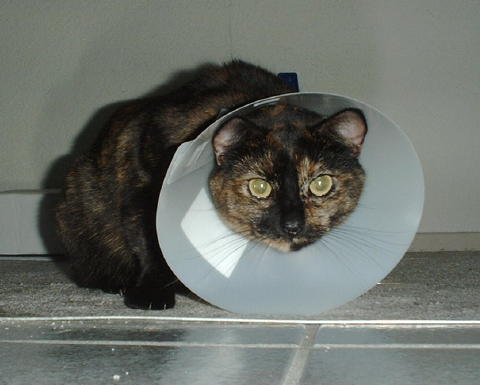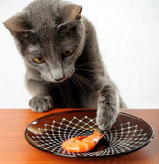Cat Skin Health

Revlon aka "Conehead" (photo above)
Cat skin health ...cat health advice and an exploration of the cat care required with the unique skin of a cat. Skin health is a varied topic that covers the actual skin and the problems that affect it such as cat fleas. For more information on the impact of cat fleas click on the link at the bottom of the page. Here, we start with a description of what the skin is.
Cats have the thinnest skin of any domestic animal. Its thickness ranges from 0.01 inch on the inside of the thighs to 0.07 inch on the back of the neck. The delicacy of a cat's skin makes it vulnerable to cuts and bruises from fighting as well as from the bristles on grooming tools.
However, the cat's skin is also very flexible. It hangs loose from the underlying muscle, so most wounds are only superficial. Cat skin health and its importance will be evident as you understand the complete picture.
The cat's skin has several layers. The protective outer layer is the epidermis which is composed of cells rich in keratin (a tough, waterproof protein) and often containing melanin (a dark pigment that shields underlying tissue against sun damage. The middle layer is the dermis. It is packed with support proteins like collagen and elastin which give skin its strength and flexibility. The dermis also contains blood vessels, nerves, hair follicles, skin glands and muscle fibers.
The hair follicles are small holes in the dermis that produce and anchor the hairs of your cat's coat. Around the base of each hair follicle are two or three sebaceous glands, which secretes seburn. That's the stuff that makes your cat's fur shine!!!
Also near the follicles are apocrine sweat glands, which secrete a milky, scented fluid thought to play a role in sexual attraction. These are not to be confused with eccrine glands which are not located near the follicles but are on the hairless foot pads and help to dissipate heat.
Each hair follicle has an arrector pill muscle. It contracts to make the hair stand on end. Nothing funnier than seeing Blaze (one of my calicoes) after she's come around the corner and gotten startled by something. She has made an art of puffing herself up to look the size of a raccoon...which she is not.
The arrector pill muscle elevates the hair (piloerection) to trap air which insulates the skin in cold weather. However, it also is utilized when a cat feels threatened and makes it look bigger than it is. Blaze does this better than any other of my cats.
Motor nerves stimulate the skin glands and arrector pill muscles. Sensory nerves detect pressure, heat, pain, cold, and itch. Some sensory nerves surround the hair follicle, while others extend up through the dermis toward the epidermis.
The innermost layer of feline skin is the subcutis. It contains a matrix of fat and protein that stores energy, insulates against extremes of temperature and pads and protects organs and tissues.
If your cat refuses to leave a treated area alone you will have to put a plastic protective cone on them like my cat Revlon had (pictured above) so that they can regain good cat skin health.
Related Articles......
Return from Cat Skin Health to Cat Health Homepage
Having trouble finding what you need? Cat Health Index & Site Map
OR
Do you have a question to ask?...Questions
OR
Do you have a cat story to share?...Simply click here to go to that page!
Copyright@2010-2020 All rights reserved.Cat-health-detective.com
This website is information only. Consult a veterinarian for medical assistance

"Like Us" on Facebook
or...
"Like Us" here




















